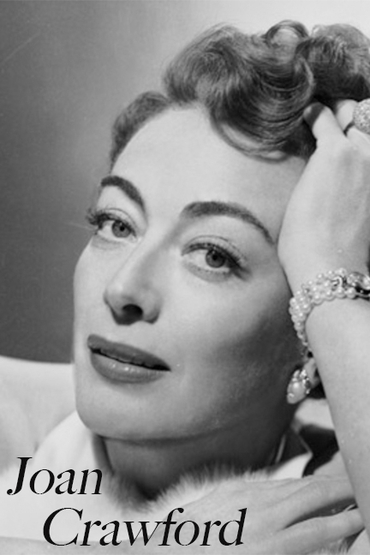"So: What happened to Joan Crawford?" an old friend and fellow movie buff asked me once.
That friend is male, and I think he was asking me, as a woman, to explain her startling metamorphosis into the mid/late career "Joan Crawford" that even non-film fans conjure up in their minds when they hear that name:
The one with the hardened face and harsh hairstyle, cartoonish brows and bolder-than-ever lips, "her once rounded jaw line turned square and heavy," indelibly embodied by Faye Dunaway in the camp biopic Mommie Dearest.
Dunaway's angular face — Crawford's own has been compared to the Chrysler Building — was the ideal canvas for the requisite makeup, but more impressively, Dunaway replicated Crawford's voice — something the fatally-miscast Jessica Lange couldn't be troubled to attempt in the disappointing mini-series Feud.
(Her co-star, Susan Sarandon, had been Bette Davis' choice to portray her in any future biopic — for obvious reasons — and she's fine in comparison, but even she failed to nail Davis' voice, something any number of amateur drag queens have pulled off. Also? Sarandon lapses in and out of Davis' idiosyncratic "here comes the bride" gait, which, as a lifelong fan, annoyed me no end. Watching me watching Feud was the closest my husband has come to experiencing my experience of sitting through latter-day movies about World War II — "That's the wrong TANK!!" — with him for the last 20 years...)
Even movie lovers may be surprised to learn that that Joan Crawford — the one my friend asked me about, Dunaway's Crawford — didn't always exist.
Did you know she appeared in over 30 silent films? Crawford's first turn in a talkie, The Hollywood Revue of 1929, remains so arresting that it's inevitably included in every other That's Entertainment-style "Can you believe it?" montage. A Charleston contest champion, she's so comfortable in her own skin here, so carefree and cheeky, we understand why no less an authority than F. Scott Fitzgerald declared:
"Joan Crawford is doubtless the best example of the flapper, the girl you see in smart night clubs, gowned to the apex of sophistication, toying iced glasses with a remote, faintly bitter expression, dancing deliciously, laughing a great deal, with wide, hurt eyes. Young things with a talent for living."
We see that same Crawford — acting but somehow not acting, at least not in the style of the time — in Grand Hotel (1932), in her early-career "ambitious shopgirl" mode.
We recognize her trademark overdrawn lips here — known as "The Slash," and variously attributed to Max Factor or William Tuttle, this look reportedly helped increase lipstick sales by 1500%.
But otherwise, Crawford's face and body are like a Calder mobile; this isn't the stiff, somber, wide-shouldered mannequin that the words "Joan Crawford" typically evoke.
She was heavily made up in Rain (1932) but for good reason: she's playing prostitute Sadie Thompson. Otherwise, that long era's softer incarnation of Crawford can be seen in, among many other movies, The Women (1939).
And in today's film, the aptly-titled A Woman's Face (1941), directed by George Cukor.
Well, you'll see it some of the time: that trailer admirably doesn't give away the movie's gimmick.
Crawford plays Anna Holm, the leader of a blackmail ring whose face was horribly scarred in a childhood fire started by her alcoholic father, leaving her bitter and ruthless. Her closest experience with love is with nasty Torsten Barring (Conrad Veidt), heir to his family's mining fortune — if only his little nephew wasn't blocking his path.
Meanwhile, Anna's attempt to blackmail a foolish young wife leads to her meeting the woman's husband, renowned plastic surgeon Dr. Gustav Segert (Melvin Douglas), who fixes her face for free. Barring realizes that, with her new appearance, Anna would be the perfect choice for his nephew's governess — one who will kill the child and put Barring one step closer to taking over the family empire. Desperate for Barring's meager affections, Anna agrees to take the job.
However, Anna is embraced by the boy and his grandfather, and her heart softens. By an amazing coincidence, Dr. Segert shows up at the Barring estate for a big party and — a lot of stuff happens.
Crawford had seen the 1938 Swedish original starring Ingrid Bergman, and lobbied MGM to buy the remake rights for her.
"Are you crazy?" studio head Louis B. Mayer asked. "Do you want the public to see you looking ugly?"
She did. In films like Of Human Bondage, Marked Woman, The Old Maid and The Private Lives of Elizabeth and Essex, Crawford's rival, Bette Davis, had become renowned for drastically altering her appearance when the part demanded it, and had been rewarded with Oscars, critical acclaim, and the respect of her peers.
Davis, in the public mind, was an actress; Crawford, a "mere" star. She wanted respect.
But Mayer was onto something, because unlike Crawford, Bette Davis had never been considered a great beauty to begin with. For Crawford to mar her face, even for a third of a movie's running time, represented a sacrifice, but one she was willing to make.
(More or less: Cukor reportedly struggled to tamp down Crawford's star persona; "While her character is physically scarred 'she's really a complete character, not the actress who's playing it,' he said later. "Then, when she becomes pretty, she becomes Joan Crawford.")
Crawford's makeup artist on A Woman's Face wasn't Max Factor, but Jack Dawn, a very different sort of technician whose credits include The Wizard of Oz and 1941's Dr. Jekyll and Mr. Hyde. To everyone's credit, Crawford's scar makeup is almost identical to Bergman's in the more astringent Swedish version: half of her face is puckered with burns, and her lip curls up into a permanent sneer.
And in a wonderful touch, whenever Crawford's post-surgery Anna briefly lapses back into bitterness and scorn, that same one-sided sneer flickers back, as if by force of life-long habit. However, one thing Bergman brought to the role that Crawford unfortunately jettisoned was her posture: Bergman's Anna is ungainly and boyish, having never learned to carry herself in a more feminine manner. Why bother?
As a film, A Woman's Face has a lot to recommend it: One of those told-in-flashback courtroom drama set-ups if you love that sort of thing; good performances all around; Richard Nichols, the most adorable little boy of the studio era, as Anna's charge; and — as if the film had been developed in a kind of onyx lacquer — an unusual but highly appropriate black "gloss" that is as close as "classy" MGM would permit itself to get to "noir."
Unfortunately, the film didn't do well; Crawford was crushed when she wasn't nominated for an Oscar, and after two other lackluster outings onscreen, Meyer bought out her contract, ending a professional relationship of almost 20 years.
Crawford landed at Warner's, where her first film (not counting a cameo in the all-star morale booster, Hollywood Canteen) was Mildred Pierce (1945).
For that performance, she finally earned not only an Academy Award nomination, but the coveted statuette itself — a victory she attributed, in part, to her peers' recollection of her serious turn in A Woman's Face.
And here we first see, at least as her character progresses from harried housewife to successful businesswoman, Joan Crawford's new "look."
As her Warner Bros. years tick by, she gets harder.
So clearly, her transformation had something to do with her studio switch. Perhaps we can credit the ministrations of Warner Bros' makeup chief Perc Westmore (whose son Monty took over later in Crawford's career after she went independent and entered the realm of grotesque camp for good, in Whatever Happened to Baby Jane? and Strait-Jacket.)
(Don't blame him for the blackface in Torch Song, though: That was Bill Tuttle again.)
Anyhow, back in 1945, she was (according to her, anyhow) 37, but more likely 40. I say that because turning 40 can do something to a woman: One can be overcome by the urge to change one's appearance, sometimes drastically.
But there's something else:
I'm pretty sure that Mildred Pierce was the first time she'd portrayed a mother onscreen — and by then, she'd been a mother offscreen for five years. Did she feel, contrary to everything we think we know about a star like her, that the time had come to look the part, however eccentrically she chose to do so?
First you're another sloe-eyed vamp
Then someone's mother
Then you're camp
While writing this column, I wondered if Stephen Sondheim had had Joan Crawford in mind when he wrote "I'm Still Here," the all-time anthem of aging divas.
Reader: He did.
Mark Steyn Club members can let Kathy know what they think of this column by logging into SteynOnline and sharing below. Membership in the Mark Steyn Club has many perks, from commenting privileges, to access to the entire SteynOnline back catalog, to exclusive invitations to Steyn events. Take out a membership for yourself or a loved one here. Kick back with Kathy and your fellow Club members in person aboard one of our annual cruises. We've rescheduled our Mediterranean voyage to next year, but it's sure to be a blast with Douglas Murray, John O'Sullivan and Michele Bachmann among Mark's special guests.

























